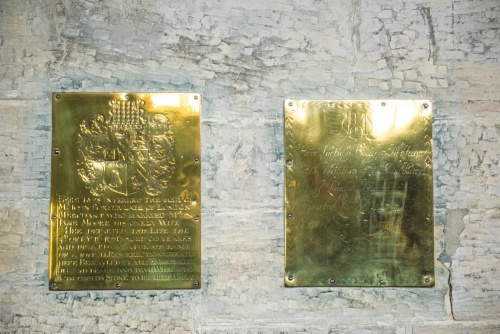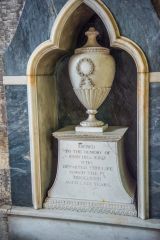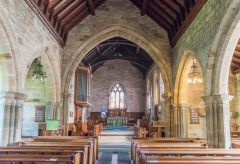
The medieval parish church of Thornton-le-Dale stands at the meeting place of three roads, including the main route from Scarborough to Pickering. There was probably a church here as early as the 7th century AD when a timber church was erected on a site of pagan worship.
The site was probably a grove of trees, used for worship of the Norse god Thor, whose name lives on in the village name.

History
That timber church was later rebuilt in stone, but this, in turn, was destroyed in 1069 during William the Conqueror's ferocious Harrying of the North. For over 30 years the settlement had no church, but in 1100 the lords of the three manors that converged here (the king, the Count of Mortain, and Berenger de Tosny) contributed to a new church in its place. That led to the unusual and sometimes problematic situation of a parish with three patrons.
Having three patrons might have been a recipe for trouble, so to head off conflict in 1226 the Archbishop of York appointed a vicar and the three patrons named a separate rector. That solution failed when the vicar refused to pay his tax and had to be moved to another parish.
In the early 14th century, the Norman church was enlarged with a new west tower, a pair of aisles, and a larger chancel. Only two features remain from the Norman building; the font and the south window in the chancel. The church is unusual in that the nave is an almost completely unaltered example of Decorated Gothic style.
In the sanctuary is an effigy thought to be that of Lady Beatrice Hastings (d 1320). Lady Beatrice lived at Low Hall, near Westgate.

The Civil Way Years
Thornton-le-Dale was caught up in the Civil War. The church's patron at that time was Sir Hugh Chomley, a Parliamentarian, who garrisoned Scarborough Castle for Parliament, then switched sides and supported the king.
The rector at the time was Rev John Robinson. He did not have the same pragmatic approach as his patron; he abandoned his parish and rode off to join the Royalist army.
In 1643 The Royalists marched on Scarborough. Sir Hugh Chomley's men met them at Howe Bridge but the Royalists charged and drove them back through the village. Chomley's men took refuge in All Saints Church. They escaped by withdrawing through the church vestry and retreating to Scarborough Castle. Sir Hugh changed sides two weeks later.

You can see the damage caused by musket balls to a pillar separating the nave from the south aisle.
Parliamentary commanders must have furious with Sir Hugh for his treachery. They sent a force of men against him, and some of these Parliamentary soldiers were billeted in the church. They amused themselves by vandalising Lady Beatrice Hasting's effigy. They broke off her face and hands and used the nave pillars to sharpen their swords. You can still see deep grooves in the nave pillars.
Sir Hugh sent a raiding party that captured the soldiers and imprisoned them in Scarborough Castle, where they remained until it fell to Parliament.
The church was heavily restored in the 1860s. As part of the restoration, the chancel floor was raised, covering the tomb of the 'Great Black Knight of the North', Sir Richard Chomley of Roxby (1516-1583).

Chomley served as the Sheriff of Yorkshire and Constable of Scarborough Castle but gained his nickname for his vast estates across the north of England, which included the former Whitby Abbey estates. Chomley suffered for his Catholic faith and his connections to the Earl and Countess of Lennox in Scotland. He was also known to have been 'consistently unfaithful' to his wife Catherine Clifford.*
On the south wall of the sanctuary is a triple sedilia, or clergy seat. Each end of the sedilia is decorated with a finely carved head.
In the chancel are memorial brasses to the Hill family. Set into a niche in the wall is a memorial to John Hill (d 1773) in the form of a neoclassical urn under a trefoil arch. Other interesting old monuments include a wall tablet to Richard Johnson Hill (d 1793) and brasses to John Porter (d 1686), Jane Porter (d 1705) and Thomas Mason and his wife (d 1744).

In the churchyard is the grave of Matthew Grimes (d 1875) who served with the 20th and 24th Infantry in India and the Peninsular Wars. He later served as a guard at St Helena over Napoleon during the former French leader's final years in exile. Grimes was one of those charged with carrying Napoleon's body to his grave. The monument was restored by the 20th Lancashire Fusiliers in 1939.
Getting There
All Saints church stands at the junction of Church Lane, Church Hill (the A170), and Priestman's Lane. The church is usually open daily to visitors and was open when we visited.
About Thornton-le-Dale, All Saints Church
Address: Church Hill,
Thornton-le-Dale,
North York Moors,
Yorkshire,
England, YO18 7QH
Attraction Type: Historic Church
Location: On Church Hill (the A170) just west of the bridge over Thornton Beck
Website: Thornton-le-Dale, All Saints Church
Location
map
OS: SE838831
Photo Credit: David Ross and Britain Express
HERITAGE
 We've 'tagged' this attraction information to help you find related historic attractions and learn more about major time periods mentioned.
We've 'tagged' this attraction information to help you find related historic attractions and learn more about major time periods mentioned.
Find other attractions tagged with:
NEARBY HISTORIC ATTRACTIONS
Heritage Rated from 1- 5 (low to exceptional) on historic interest
Ellerburn, St Hilda's Church - 0.7 miles (Historic Church) ![]()
Pickering Church - 2.5 miles (Historic Church) ![]()
Pickering Castle - 2.6 miles (Castle) ![]()
North Yorkshire Moors Railway - 2.6 miles (Museum) ![]()
Beck Isle Museum - 2.7 miles (Museum) ![]()
Scampston Hall - 5 miles (Historic House) ![]()
Cawthorn Roman Camps - 5.4 miles (Roman Site) ![]()
The Bridestones - 5.6 miles (Countryside) ![]()
Nearest Holiday Cottages to Thornton-le-Dale, All Saints Church:
Thornton-le-Dale, Yorkshire
Sleeps: 5
Stay from: £527 - 1756
Thornton-le-Dale, Yorkshire
Sleeps: 6
Stay from: £424 - 1630
More self catering near Thornton-le-Dale, All Saints Church













